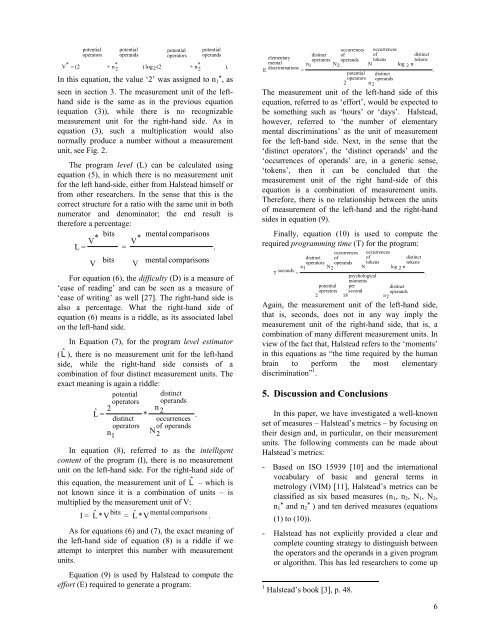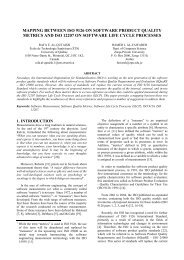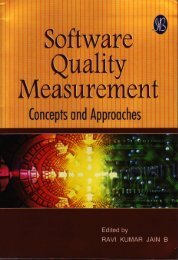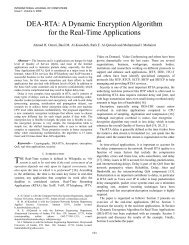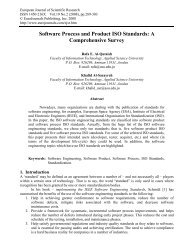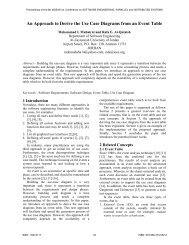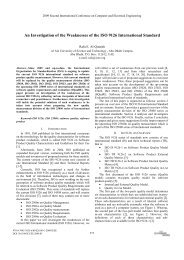An Analysis of the Design and Definitions of Halstead's Metrics
An Analysis of the Design and Definitions of Halstead's Metrics
An Analysis of the Design and Definitions of Halstead's Metrics
You also want an ePaper? Increase the reach of your titles
YUMPU automatically turns print PDFs into web optimized ePapers that Google loves.
*V = (2potentialoperators*+ n 2potentialoper<strong>and</strong>s) log2(2potentialoperators*+ n 2potentialoper<strong>and</strong>sIn this equation, <strong>the</strong> value ‘2’ was assigned to n * 1 , asseen in section 3. The measurement unit <strong>of</strong> <strong>the</strong> lefth<strong>and</strong>side is <strong>the</strong> same as in <strong>the</strong> previous equation(equation (3)), while <strong>the</strong>re is no recognizablemeasurement unit for <strong>the</strong> right-h<strong>and</strong> side. As inequation (3), such a multiplication would alsonormally produce a number without a measurementunit, see Fig. 2.The program level (L) can be calculated usingequation (5), in which <strong>the</strong>re is no measurement unitfor <strong>the</strong> left h<strong>and</strong>-side, ei<strong>the</strong>r from Halstead himself orfrom o<strong>the</strong>r researchers. In <strong>the</strong> sense that this is <strong>the</strong>correct structure for a ratio with <strong>the</strong> same unit in bothnumerator <strong>and</strong> denominator; <strong>the</strong> end result is<strong>the</strong>refore a percentage:bits mental comparisonsV*V*L = =.VbitsVmental comparisonsFor equation (6), <strong>the</strong> difficulty (D) is a measure <strong>of</strong>‘ease <strong>of</strong> reading’ <strong>and</strong> can be seen as a measure <strong>of</strong>‘ease <strong>of</strong> writing’ as well [27]. The right-h<strong>and</strong> side isalso a percentage. What <strong>the</strong> right-h<strong>and</strong> side <strong>of</strong>equation (6) means is a riddle, as its associated labelon <strong>the</strong> left-h<strong>and</strong> side.In Equation (7), for <strong>the</strong> program level estimator(Lˆ ), <strong>the</strong>re is no measurement unit for <strong>the</strong> left-h<strong>and</strong>side, while <strong>the</strong> right-h<strong>and</strong> side consists <strong>of</strong> acombination <strong>of</strong> four distinct measurement units. Theexact meaning is again a riddle:potential distinctoperators oper<strong>and</strong>s2n 2Lˆ = *.distinct occurrencesoperators <strong>of</strong> oper<strong>and</strong>sn N12In equation (8), referred to as <strong>the</strong> intelligentcontent <strong>of</strong> <strong>the</strong> program (I), <strong>the</strong>re is no measurementunit on <strong>the</strong> left-h<strong>and</strong> side. For <strong>the</strong> right-h<strong>and</strong> side <strong>of</strong>this equation, <strong>the</strong> measurement unit <strong>of</strong> Lˆ – which isnot known since it is a combination <strong>of</strong> units – ismultiplied by <strong>the</strong> measurement unit <strong>of</strong> V:I =bits mental comparisonsLˆ *V = Lˆ *V.As for equations (6) <strong>and</strong> (7), <strong>the</strong> exact meaning <strong>of</strong><strong>the</strong> left-h<strong>and</strong> side <strong>of</strong> equation (8) is a riddle if weattempt to interpret this number with measurementunits.Equation (9) is used by Halstead to compute <strong>the</strong>effort (E) required to generate a program:).Eelementarymentaldiscriminationsn1=distinctoperatorsoccurrences<strong>of</strong>oper<strong>and</strong>sN2N2potentialoperatorsn2occurrences<strong>of</strong>tokensdistinctoper<strong>and</strong>sdistincttokenslog 2 n.The measurement unit <strong>of</strong> <strong>the</strong> left-h<strong>and</strong> side <strong>of</strong> thisequation, referred to as ‘effort’, would be expected tobe something such as ‘hours’ or ‘days’. Halstead,however, referred to ‘<strong>the</strong> number <strong>of</strong> elementarymental discriminations’ as <strong>the</strong> unit <strong>of</strong> measurementfor <strong>the</strong> left-h<strong>and</strong> side. Next, in <strong>the</strong> sense that <strong>the</strong>‘distinct operators’, <strong>the</strong> ‘distinct oper<strong>and</strong>s’ <strong>and</strong> <strong>the</strong>‘occurrences <strong>of</strong> oper<strong>and</strong>s’ are, in a generic sense,‘tokens’, <strong>the</strong>n it can be concluded that <strong>the</strong>measurement unit <strong>of</strong> <strong>the</strong> right h<strong>and</strong>-side <strong>of</strong> thisequation is a combination <strong>of</strong> measurement units.Therefore, <strong>the</strong>re is no relationship between <strong>the</strong> units<strong>of</strong> measurement <strong>of</strong> <strong>the</strong> left-h<strong>and</strong> <strong>and</strong> <strong>the</strong> right-h<strong>and</strong>sides in equation (9).Finally, equation (10) is used to compute <strong>the</strong>required programming time (T) for <strong>the</strong> program:distinctoperatorsn 1Tseconds=occurrences<strong>of</strong>oper<strong>and</strong>sN 2potentialoperators2psychologicalmomentspersecond18occurrences<strong>of</strong>distincttokenstokensNlog 2 n.distinctoper<strong>and</strong>sn 2Again, <strong>the</strong> measurement unit <strong>of</strong> <strong>the</strong> left-h<strong>and</strong> side,that is, seconds, does not in any way imply <strong>the</strong>measurement unit <strong>of</strong> <strong>the</strong> right-h<strong>and</strong> side, that is, acombination <strong>of</strong> many different measurement units. Inview <strong>of</strong> <strong>the</strong> fact that, Halstead refers to <strong>the</strong> ‘moments’in this equations as “<strong>the</strong> time required by <strong>the</strong> humanbrain to perform <strong>the</strong> most elementarydiscrimination” 1 .5. Discussion <strong>and</strong> ConclusionsIn this paper, we have investigated a well-knownset <strong>of</strong> measures – Halstead’s metrics – by focusing on<strong>the</strong>ir design <strong>and</strong>, in particular, on <strong>the</strong>ir measurementunits. The following comments can be made aboutHalstead’s metrics:- Based on ISO 15939 [10] <strong>and</strong> <strong>the</strong> internationalvocabulary <strong>of</strong> basic <strong>and</strong> general terms inmetrology (VIM) [11], Halstead’s metrics can beclassified as six based measures (n 1 , n 2 , N 1 , N 2 ,n * 1 <strong>and</strong> n * 2 ) <strong>and</strong> ten derived measures (equations(1) to (10)).- Halstead has not explicitly provided a clear <strong>and</strong>complete counting strategy to distinguish between<strong>the</strong> operators <strong>and</strong> <strong>the</strong> oper<strong>and</strong>s in a given programor algorithm. This has led researchers to come up1 Halstead’s book [3], p. 48.6


